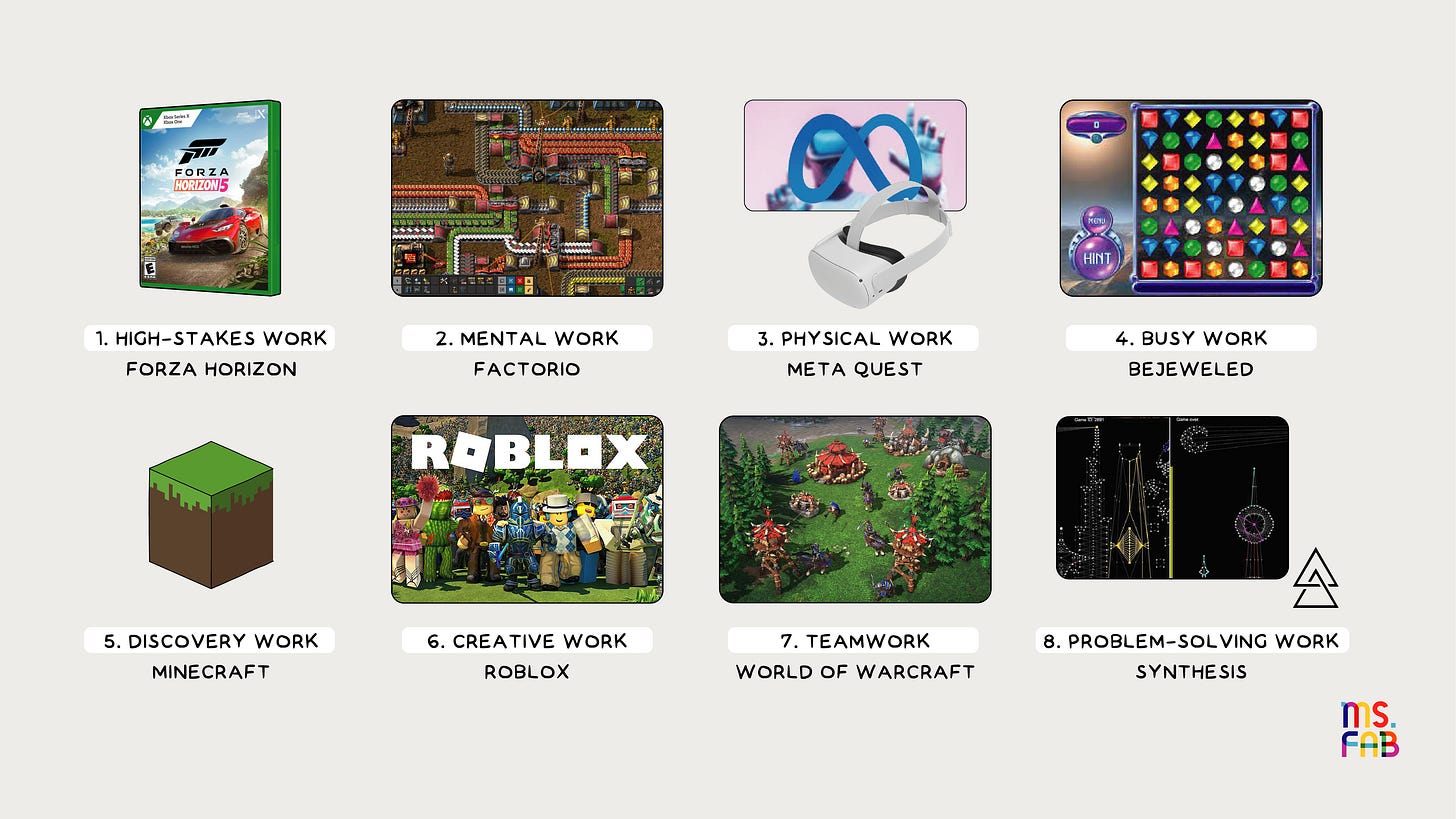Fab Fridays 85: What Games to Play?
8 Kinds of Work in Video Games
Last week, I shared an interesting case for why kids should play more video games.
Many of you asked which games are best…here are some recommendations.
First, let’s recap why video games are so valuable:
They’re essentially simulations of reality. Through video games, kids learn skills that are key for success in real life, like how to think, solve problems, and work with others.
Read more below:
To teach these skills, video games invite players to complete tasks.
In other words, they engage kids in work.
In her book, Reality is Broken, PhD game designer Jane McGonigal lists seven kinds of work from different types of games:
HIGH-STAKES WORK
This is the kind of work that typically comes to mind when we think about video games. Action and racing games, like Forza Horizon, get players’ hearts pounding. They learn how to make fast decisions, take quick action, and stay calm under pressure.MENTAL WORK
Think of strategy games like Factorio. They stretch our minds, force players to consider the consequences of their actions, and encourage them to prepare for the unexpected.
PHYSICAL WORK
Many games today encourage players to move—and this will only increase as Virtual Reality games grow in popularity. Gaming systems like Meta Quest get kids active and out of their seats.
BUSYWORK
Games like Bejeweled let players do predictable, repetitive tasks. It sounds boring, but players love it. Bejeweled focuses kids’ minds, distracts them from the stress of life, and helps them feel accomplished.
DISCOVERY WORK
Think of open-world games like Minecraft. Kids enjoy the thrill of exploring new places and then adding their touch by building their own landscapes, buildings, and more.
CREATIVE WORK
Platforms like Roblox empower kids to design their own games. They get to experience the satisfaction of making something new, releasing it to the world, and watching others use their creations.
TEAMWORK
Games today are increasingly focused on collaboration. Think of World of Warcraft, where players form teams to complete raids. Kids learn how to achieve goals by communicating and coordinating with large groups of other players.
In addition to Jane’s seven kinds of work, there’s another one: PROBLEM-SOLVING
This is the kind of work kids do at Synthesis. It involves high stakes, strategy, discovery, creativity, and teamwork, but it also takes something much more.
To win these complex games, kids learn conjecture and criticism. They propose crazy ideas, debate proposals, and test their opinions by taking action. Through this process, kids practice tackling extreme challenges, like managing wildfires and colonizing space.
All the games above can benefit kids because they require meaningful work. But to figure out which are best, parents need to ask:
“Which games do my kids enjoy the most?”
At the end of the day, we may pick the very “best” games for our kids, but if they don’t like playing them, they won’t experience any of the benefits. For kids to reap the rewards of video games, they need autonomy.
Read more below:
Learning is first and foremost an opt-in activity.
If we force certain video games on kids, we eliminate the chance for them to genuinely learn. To learn from games, kids need to have fun.
If you'd like to learn more about the benefits of gaming, checkout this podcast with Jane McGonigal and Patrick O'Shaughnessy.
Until next week,
Ms. Fab





